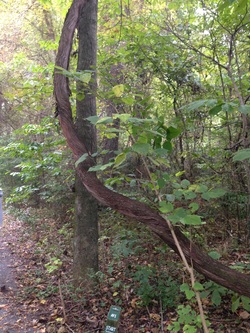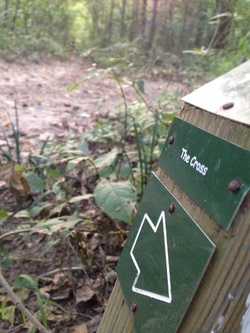The Old Forest Offers a Glimpse into the Past
 Wild grape vines
Wild grape vines If you ever wondered what Memphis looked like 10,000 years ago, just take a trip to Overton Park. Sprawled out across 126 acres, the appropriately named Old Forest stands apart from its urban setting like a portal into the past.
Prior to 1901, what is now Overton Park was known as Lea’s Woods—a vast expanse of old growth forest that remained relatively unchanged since the end of the last Ice Age. When park
planner George Kessler designed Overton Park he sat aside 172 acres of pristine woodland to be designated as the Old Forest.
Since then, the park and the surrounding city have changed greatly, but the forest remains the same.
That is unless you know where to look.
“The forest is always changing,” Roy Barnes said, as he stops to show a group of day hikers an example of pit-and-mound topography.
Barnes is the president of Citizens to Preserve Overton Park, which is the modern day incarnation of a group that garnered national attention in the early 1970s by halting former U.S. Secretary of Transportation Jim Volpe’s plan to run Interstate 40 through the middle of the park. The Supreme Court case, Citizens to Preserve Overton Park v. Volpe, was landmark case for the conservation of public lands.
Prior to 1901, what is now Overton Park was known as Lea’s Woods—a vast expanse of old growth forest that remained relatively unchanged since the end of the last Ice Age. When park
planner George Kessler designed Overton Park he sat aside 172 acres of pristine woodland to be designated as the Old Forest.
Since then, the park and the surrounding city have changed greatly, but the forest remains the same.
That is unless you know where to look.
“The forest is always changing,” Roy Barnes said, as he stops to show a group of day hikers an example of pit-and-mound topography.
Barnes is the president of Citizens to Preserve Overton Park, which is the modern day incarnation of a group that garnered national attention in the early 1970s by halting former U.S. Secretary of Transportation Jim Volpe’s plan to run Interstate 40 through the middle of the park. The Supreme Court case, Citizens to Preserve Overton Park v. Volpe, was landmark case for the conservation of public lands.
 "The Cross" section of the OFT
"The Cross" section of the OFT These days the group still protects the park, but now they are more concerned with invasive plant species such as English ivy, or the dreaded kudzu, than Supreme Court rulings. Today, Barnes is leading one of CPOP’s bimonthly nature walks around the Old Forest Trail.
While the trails are always open to the public, on the second Saturday and the last Sunday of every month a representative from CPOP leads a 1.5 mile nature walk through the Old Forest to explore the rich biodiversity that inhabits the state natural area.
In 2009 the City of Memphis hired Dr. Thomas Heineke to catalogue the flora inside the old growth forest. What he found was nothing short of amazing.
“Very few virgin forests exist in the Mid-South region and certainly none within a city the size of Memphis,” Heineke said in his report. “Many of the trees reach heights well over 100 feet and measure four to five feet or larger in diameter at breast height. A large number of these trees are likely greater than 200 years of age.”
In his report Heineke catalogued over 70 different species of trees, including 11 species of oak, 332 species of flowering plants from 85 families, two of which, goldenseal and oceanblue phacelia, are on the Tennessee Natural Heritage Program Rare Plant List and an astounding eight different species of wild grape vines, some of which are as old as the trees they cling to.
While the trails are always open to the public, on the second Saturday and the last Sunday of every month a representative from CPOP leads a 1.5 mile nature walk through the Old Forest to explore the rich biodiversity that inhabits the state natural area.
In 2009 the City of Memphis hired Dr. Thomas Heineke to catalogue the flora inside the old growth forest. What he found was nothing short of amazing.
“Very few virgin forests exist in the Mid-South region and certainly none within a city the size of Memphis,” Heineke said in his report. “Many of the trees reach heights well over 100 feet and measure four to five feet or larger in diameter at breast height. A large number of these trees are likely greater than 200 years of age.”
In his report Heineke catalogued over 70 different species of trees, including 11 species of oak, 332 species of flowering plants from 85 families, two of which, goldenseal and oceanblue phacelia, are on the Tennessee Natural Heritage Program Rare Plant List and an astounding eight different species of wild grape vines, some of which are as old as the trees they cling to.
 Wild mushrooms after a rain
Wild mushrooms after a rain “Overton Park Forest is a unique resource which cannot be replaced,” Heineke said. “It is invaluable to the city and to the region as an outstanding example of old growth forest. Because it is within an urban setting, it is even more exceptional. Everything possible should be done to assure that it is protected in perpetuity. This forest is indeed extraordinary and unequaled.”
 RSS Feed
RSS Feed